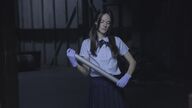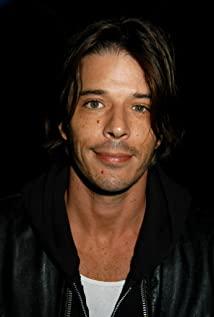The part of this drama is quite low. It is understandable that this series is positioned as a B-grade film after all, and those who want to watch simple and crude QJ nude scenes are expected to be greatly disappointed. Moreover, as an exploitative film, the depth of discussion is limited, the lines are relatively straightforward, and the production of script performances and scenes is relatively moderate. If you want to watch a movie with depth, you don’t need to get it from this one. But as far as this series (and this type of film) is concerned, this work not only continues the framework of the previous Rape&revenge, but also intentionally changes the presentation of the sexual assault part; it looks more feminist and more feminine, but in the end it loses control of the heroine The performance does not seem to be without criticism of the complete acceptance of feminism, and this possible "criticism" further deepens the fact that sexual assault is not only a physical, but also a long-term mental damage to women, continuing the previous work's treatment of sexuality. Criticism and resistance to aggression. The various contradictions are unified and contradictory, and it is interesting to examine them carefully.
As a spit series, the original program should spend about two-thirds of the time presenting very graphic & erotic (for some audiences) assault shots, and then one-third of the time with a clean and violent counter-kill. However, in the first half of the film, there was no direct presentation of sexual assault; even the scene that caused the heroine's revenge friend to be raped and murdered was not filmed (you must know that this is the biggest gimmick and the most complicated part of this type of film) , but through other people's cryptic and vague retelling-the therapist euphemistically and constantly "delayed" to inform Marla's death, and the detective could not disclose the details of the case. It's a far cry from the previous spit series and most similar revenge films (one is intuitive, one is twisty and ambiguous), and it's interesting.
This kind of expression is very friendly to female audiences (or those who don't like the abuse part so much), and many viewers who watch the feeling of revenge finally don't have to skip or endure the long infringement process in the early stage, and can watch the torture directly. This makes the revenge movie seem more feminine. But on the other hand, because of the lack of intuitive and cruel assault shots, some viewers may have emotional shifts and cannot empathize well with the heroine and the victim (in the context of the movie).
On the other hand, while the film doesn't choose to present graphic rape scenes, the entire show is all about rape. The gradual breakdown of the heroine's spirit, the scenes of constantly being violated, often have violent fantasy, from hot-blooded revenge to cold-blooded violence, from "rising resistance" to "incarnation of justice" to "bloodthirsty demon", all of which are PTSD after being raped lead to the transformation of spiritual personality. Different people in group therapy mentioned different experiences of being raped, and different experiences reflected indifference from relatives (Cassie's mother), social discrimination (Kosca's daughter was called slut), judicial injustice and inaction (violating Kosca's daughter) The bodybuilder, the ex who killed Marla is on the loose), self-criticism (Cassie thinks I deserve this), the therapist's indifference (whether it's single therapy in prison or group therapy), forcibly instilling values, all are images again and again. The rape behavior above is the second or third injury after the real violation occurs. Audiences who are looking forward to watching Torture Porn will be disappointed, and will find the first half of the rhythm slow and boring, but the film just tells the rape in a different way. The lines in this part are actually as straightforward as the graphic's infringing scenes, and the same attempt is made to follow The audience establishes emotional connections and accumulates the so-called "revenge refreshment", but many people choose to ignore it.
Because of the weakening of the sexual assault scenes and the intensification of the torture and killing parts, and the female protagonist being the goddess of nemesis because of the injustice of justice to seek justice for the women who were violated, this film seems to be cheering for women's rights - look, we have to resist ourselves and use violence to control violence. However, the film does not stop at "reasonable" revenge, but makes the heroine's violence escalate again and again, from revenge for friends to revenge for other members of the group or relatives of members [Actually, I think the order of the three killings here can be changed, from The aggressor who "reported by the victim and admitted by the aggressor" (Cassie's stepfather), to the aggressor who "listens to the group members' narration" (fitness man), to the aggressor who "no evidence and only speculates" (Marla's ex), one step From "violations with reliable evidence" to "violations based on speculation"], to fishing and law enforcement against people who did not commit violations, to often fighting with other female prisoners in prison, to killing everything in fantasy The person (therapist) who provoked not even provoked himself has gone from being "just" to being completely out of control. When she turned the knife on innocent people and even women, what followed her mental world collapsed was the logic of "revenge for the victim is just", "injustice of justice should be done with violence" and "revenge on men" , this film also went from pro-feminism to (over) the edge of criticizing extreme feminism. Vigilante's behavior is inherently controversial, whether individual will can override the system, how to define the boundaries of "justice" and "injustice", and how to prevent landslides, these are the topics that have been constantly discussed in Vigilante-themed works. The vigilante of this film is a severely traumatized, mentally unstable person who is gradually losing control. Obviously, letting such an individual exercise "justice" is very likely to fall into the quagmire of "injustice". As a vigilante, the final runaway behavior of such a person can be expected. This film also inherently includes support and criticism for vigilante/feminist revenge.
All in all, this film uses a different approach than the series, conveying seemingly contradictory themes (which can be interpreted differently by different people, which may also result in extreme scores). But no matter how the rape is presented, the support or criticism of the heroine's behavior, the controversy over judicial justice and vigilante, the core is still a tragic story of the victimized individuals and groups. While revenge is cool, it's still a sad story.
————————
1. About PTSD:
- Maybe not only the pseudo-killing/revenge clips that were obviously presented in the early stage are fantasy, but even the vision/mocking of those strange men may be imaginary, as well as being overly sensitive to the friendliness of male colleagues, all of which are caused by PTSD (possibly) right Overinterpretation or misinterpretation of reality.
- jogging/running scene --> live that day everyday
- everybody is after something - lose hope for humanity, predator or prey
- Haven't smoked for a long time --> Smoking was stigmatized before / considered a symbol of city girl / not self-respect, avoid bad memory
2. Regarding secondary damage:
- Whether individual or group therapy, the therapists are just so indifferent - the rapists
- There are many scenes of blame the victim in the film: Marla died, detective asked the heroine M if she liked rough sex/whether it was because M was weak; Kosca's daughter was raped, others accused her of being a slut; met in a bar The old man said "Maybe this is what they want", completely rapist thinking; Cassie's self-blame (internalized blame the victim): "Bad things happened to me because I didn't say it right away, as if I like it the same way." These are all serious secondary injuries to the victim that happened in real life.
3. Regarding reality and fantasy/unreliable narratives (different interpretations possible):
- There may be a difference between the reality of sexual assault victims and the real reality: in the reality of women who have been hurt, all men are terrible: inadvertently glance at passers-by who make them uncomfortable, showing good intentions must be thinking Colleagues who go to bed, gangsters who suddenly crowd around on the road, beggars who give him money and talk shit, alcoholics who think "they like it this way" rapists, etc. But the actual reality is a mixture of good and bad/or just grey, the co-workers may just want to be friendly, the seemingly incompetent cops may not seem ruthless (although the various hints of Marla's death are still uncomfortable), and even the malicious ones imagined at the beginning. "Sneak peeking" may be because you are too sensitive, or even hallucinations.
- The first three clips of getting along with men are all presented after the therapist asks "dreams again?", and then the recollection clip and the clip of getting up from the bed are connected, and the clip of therapy has several scenes of "waking up from the sofa" . It seems to imply the blurring of the boundaries between reality, memory, fantasy, and dreams.
- Marla is too like a fantasy character. While saying that "friendship" does not exist, "everyone is after something", she easily accepts a like-minded friend, and J never seems to ask her name, these obviously do not make sense. The gut the fish mentioned by M is reminiscent of the fish that J killed when he killed Stanley at that time. The tools he fiddled with when he went to the supermarket with her were also related to her previous revenge tactics, and the incompetence of the judicial system led to the killing of M. The murderer walked away, which led to J's killing spree, which was also closely related to the fact that she had been violated by the police before, and she did not believe in the judicial system for a long time. The escalation of the heroine's violent behavior was also led by an "imaginary friend" who "slightly punished" and killed herself. Her revenge fantasies are her fantasies. Her death was just a (probably fanciful) excuse for her PTSD/mental disorder/path to murder, just like Joker's mother's death and her neighbor's "betrayal" are self-told lies.
- The narrative of the whole story is really choppy, confusing, contradictory, and unreal. J had been wearing a quilt when he saw the therapist, and finally revealed the prison uniform inside, revealing that the entire treatment process was carried out after the arrest (two years), and the previous life fragments were only fragments of memories. However, the content of the previous conversation (such as recommending J to go to group therapy) is consistent with the timeline of her experience before being imprisoned. It seems that part of the therapy happened before her arrest (this can be interpreted differently). If understood in this direction, this seems to be a chronological contradiction. But it is these "unreasonable" that illustrate J's mental state: unstable, unreliable, illogical, can't tell fantasy from reality, like dreams when you're awake. Maybe those so-called "memory fragments" are just fantasies. Another interpretation is that perhaps the incident of seeing the therapist may not necessarily have happened. It can be interpreted as a collision between her inner self-regulation and violent impulses in the process of gradually losing control, and finally "killing" the therapist. The imagery suggests that the spirit is completely out of control (killing the therapist may not actually happen, because the bloodstains disappeared after J turned around, but at this time the boundary between reality and fantasy has been blurred, which can be interpreted as either a real occurrence or a non-occurrence). The whole story starts from the memories that emerge all the time, to the killing fantasy that the audience can see, to the friends who can't tell the truth from the fake, to the whole story that can be interpreted in multiple ways. The mental system is very consistent. Perhaps this film is not about an illogical, chaotic story, but a process in which a chaotic mental system collapses.
- The way the whole story is interspersed with therapy and life segments is a bit like Joker, and the way to kill (or fantasize about killing) the therapist at the end is also similar. Although the bloodstains disappeared at the end of the play, and Joker appeared bloodstains, but because of the unstable mental state and unreliable narrative of the two protagonists, the boundary between reality and fantasy is blurred, so different appearances may express similar connotations. Obviously Joker's artistry is much higher, but the two can be viewed in contrast, and maybe there will be a different experience (well, I went to watch Joker again).
4. About women's rights
- Regarding the surname made up by the heroine, you can contact Lucifer: the falling angle, the avenging angle, the angle-devil, the (false) morning star - the symbol of the heroine (the heroine is called Angela after changing her name). The image of "venus is the actual morning star" is very interesting. It seems that the heroine is a Venus/pioneer of women's rights crusade against men's rights, but because of mental instability, violence is suppressed by violence, and the anti-social society is out of the scope of revenge. behavior, making this behavior more like a manifestation of "pseudo-feminism". So I think this is not just a "feminist" movie, "feminism" is expressed in an extreme form, but may be a criticism of extreme feminism (but this does not affect the heroine who was a victim of serious violations) the fact of the victim; the transformation from the victim to the extreme perpetrator is inherently a tragedy).
- As a so-called "revenge film", the scene where the heroine's friend was raped and murdered by the heroine's vengeance spree was not filmed, but was relayed by others. Detective even covered up the details, which is different from the previous The spit series is very different from most similar revenge films, which is interesting. This narrative of reducing violence scenes is much more friendly to female audiences. On the one hand, it focuses on the power of women and shows feminist tendencies. You can also add an argument to the theory of "imaginary friend" (point 5) - because the violation did not exist in this timeline, but originated from the timeline of the previous episode, this "killed friend" It's just a fantasy from the last serious trauma.
- The interesting thing about this movie is that its target audience for the first series is arguably very different from the target audience for the third. Most of the people who can take pleasure from the rape scene can't understand the mentality of the victim, and read various comments: "only fancy male abuse", "chaos without logic", "too much preaching", "instilling women's rights", blablabla . But the film actually wants to tell the audience through the victim: welcome to our wolrd. Chaos, violence, hatred, rage, excess, distortion, this is not "indoctrination", "reasonable", this is the mentality of the victims, their reality is already different from that of normal people. It's just that not many people understand
5. On reality: justice and victimizer
- The judicial system in the film was unable to exercise justice, and let go of the ex who was suspected of killing Marla and the bodybuilder who was suspected of killing Kosca's daughter (Kosca recounted that he guided her daughter to report the case and believed the judicial system, but was failed by the system and failed her daughter at the same time. The plot is heartbreaking). So the heroine took up the duty of exercising justice and became a vigilante, so that those who should be punished were punished. But the other side of this matter is that the death penalty (or massacre) is set on the basis of personal will directly through the narrative and speculation of others, without evidence. what if some/some of the men who were killed were not really the murderers? Is the heroine's revenge still "just"? (Go to DD's discussion of vigilante and justice)
- In the heart of the heroine, everyone is either a predator or a prey, similar to being a victim or a victimizer - Paving the way for the heroine to become a victimizer
- Different from the religious elements often used in revenge series (such as going to church before revenge, but this one also has Lucifer's religious imagery), this film uses more "worldly" therapeutic clips to show the characters' inner changes and Concept collision. Because this time has nothing to do with God, redemption or sin, the heroine will neither forgive nor ask for forgiveness. There is only justice that cannot be satisfied normally (through the system) in the secular world, and the collapse of the post-creation spiritual world.
- To expand: In this film, the heroine becomes the avenger as the female victim, some people like it or gain inner strength, even when she turns the knife on other men who have not violated the aggression or even everyone, some people also I think there is no problem. What about victims of other crimes? For example, those who have been brutalized since childhood and then become criminals or murderers? Most people don't have much sympathy for them. "We don't want to know the stories behind them, only the facts of their violence." This psychology makes sense, especially when former abusers turn to harming innocents. But this kind of change in the psychology and personality of the victim becoming the perpetrator is actually the same as the direction the heroine will go in the play. The victim turns to offender/victimizer is a cycle that is difficult to break, a series of tragedies. In the end, it is necessary to return to the system, system, and society, and hope that the system can prevent more initial injuries, help victims relieve themselves, and not become the perpetrators of the next cycle. Some cycles can only be broken by the system, which is why the system is most powerless when it is corrupt and incompetent, and individual acts of revenge or punishment can be forgiven or even supported.
6. Others:
- When the heroine discussed with the detective why M went to see the ex, she was hesitant, she said that she "will never put herself in a dangerous environment/in front of people again, (unless)...". My understanding is that J probably thought that M was meant to take revenge on ex, like she killed several people who violated her before, but things went wrong. She can't tell detective this, one is that it is not good for catching ex, and the other is that it may expose her past experience.
- The injury you get when you kill a gym boy is not the same as the injury you get when you see a therapist. From the last chat with the therapist, it can be seen that J often fights with other people in the prison, and these wounds should be caused by fighting. Two injuries put together can serve to blur the timeline.
- Vengeance. Vigilante. Violence. What's wrong with "V"?
View more about I Spit on Your Grave: Vengeance Is Mine reviews










